Jesus wasn’t white: he was a brown-skinned, Middle Eastern Jew. Here’s why that matters
Robyn J. Whitaker
Bromby Senior Lecturer in Biblical Studies, Trinity College, University of Divinity
Disclosure statement
Robyn Whitaker is a member of the Centre for Research in Religion and Public Policy
Partners
I grew up in a Christian home, where a photo of Jesus hung on my bedroom wall. I still have it. It is schmaltzy and rather tacky in that 1970s kind of way, but as a little girl I loved it. In this picture, Jesus looks kind and gentle, he gazes down at me lovingly. He is also light-haired, blue-eyed, and very white.
The problem is, Jesus was not white. You’d be forgiven for thinking otherwise if you’ve ever entered a Western church or visited an art gallery. But while there is no physical description of him in the Bible, there is also no doubt that the historical Jesus, the man who was executed by the Roman State in the first century CE, was a brown-skinned, Middle Eastern Jew.
This is not controversial from a scholarly point of view, but somehow it is a forgotten detail for many of the millions of Christians who will gather to celebrate Easter this week.
On Good Friday, Christians attend churches to worship Jesus and, in particular, remember his death on a cross. In most of these churches, Jesus will be depicted as a white man, a guy that looks like Anglo-Australians, a guy easy for other Anglo-Australians to identify with.
Think for a moment of the rather dashing Jim Caviezel, who played Jesus in Mel Gibson’s Passion of the Christ. He is an Irish-American actor. Or call to mind some of the most famous artworks of Jesus’ crucifixion – Ruben, Grunewald, Giotto – and again we see the European bias in depicting a white-skinned Jesus.
Does any of this matter? Yes, it really does. As a society, we are well aware of the power of representation and the importance of diverse role models.
After winning the 2013 Oscar for Best Supporting Actress for her role in 12 Years a Slave, Kenyan actress Lupita Nyong’o shot to fame. In interviews since then, Nyong’o has repeatedly articulated her feelings of inferiority as a young woman because all the images of beauty she saw around her were of lighter-skinned women. It was only when she saw the fashion world embracing Sudanese model Alek Wek that she realised black could be beautiful too.
If we can recognise the importance of ethnically and physically diverse role models in our media, why can’t we do the same for faith? Why do we continue to allow images of a whitened Jesus to dominate?
Bromby Senior Lecturer in Biblical Studies, Trinity College, University of Divinity
Disclosure statement
Robyn Whitaker is a member of the Centre for Research in Religion and Public Policy
Partners
I grew up in a Christian home, where a photo of Jesus hung on my bedroom wall. I still have it. It is schmaltzy and rather tacky in that 1970s kind of way, but as a little girl I loved it. In this picture, Jesus looks kind and gentle, he gazes down at me lovingly. He is also light-haired, blue-eyed, and very white.
The problem is, Jesus was not white. You’d be forgiven for thinking otherwise if you’ve ever entered a Western church or visited an art gallery. But while there is no physical description of him in the Bible, there is also no doubt that the historical Jesus, the man who was executed by the Roman State in the first century CE, was a brown-skinned, Middle Eastern Jew.
This is not controversial from a scholarly point of view, but somehow it is a forgotten detail for many of the millions of Christians who will gather to celebrate Easter this week.
On Good Friday, Christians attend churches to worship Jesus and, in particular, remember his death on a cross. In most of these churches, Jesus will be depicted as a white man, a guy that looks like Anglo-Australians, a guy easy for other Anglo-Australians to identify with.
Think for a moment of the rather dashing Jim Caviezel, who played Jesus in Mel Gibson’s Passion of the Christ. He is an Irish-American actor. Or call to mind some of the most famous artworks of Jesus’ crucifixion – Ruben, Grunewald, Giotto – and again we see the European bias in depicting a white-skinned Jesus.
Does any of this matter? Yes, it really does. As a society, we are well aware of the power of representation and the importance of diverse role models.
After winning the 2013 Oscar for Best Supporting Actress for her role in 12 Years a Slave, Kenyan actress Lupita Nyong’o shot to fame. In interviews since then, Nyong’o has repeatedly articulated her feelings of inferiority as a young woman because all the images of beauty she saw around her were of lighter-skinned women. It was only when she saw the fashion world embracing Sudanese model Alek Wek that she realised black could be beautiful too.
If we can recognise the importance of ethnically and physically diverse role models in our media, why can’t we do the same for faith? Why do we continue to allow images of a whitened Jesus to dominate?
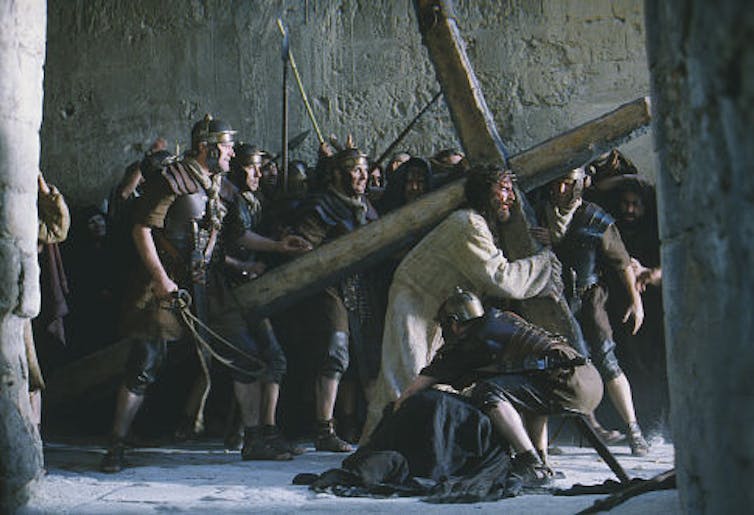
Jim Caviezel in Mel Gibson’s 2004 film The Passion of the Christ. IMDB
Many churches and cultures do depict Jesus as a brown or black man. Orthodox Christians usually have a very different iconography to that of European art – if you enter a church in Africa, you’ll likely see an African Jesus on display.
But these are rarely the images we see in Australian Protestant and Catholic churches, and it is our loss. It allows the mainstream Christian community to separate their devotion to Jesus from compassionate regard for those who look different.
I would even go so far as to say it creates a cognitive disconnect, where one can feel deep affection for Jesus but little empathy for a Middle Eastern person. It likewise has implications for the theological claim that humans are made in God’s image. If God is always imaged as white, then the default human becomes white and such thinking undergirds racism.
Historically, the whitewashing of Jesus contributed to Christians being some of the worst perpetrators of anti-Semitism and it continues to manifest in the “othering” of non-Anglo Saxon Australians.
This Easter, I can’t help but wonder, what would our church and society look like if we just remembered that Jesus was brown? If we were confronted with the reality that the body hung on the cross was a brown body: one broken, tortured, and publicly executed by an oppressive regime.
How might it change our attitudes if we could see that the unjust imprisonment, abuse, and execution of the historical Jesus has more in common with the experience of Indigenous Australians or asylum seekers than it does with those who hold power in the church and usually represent Christ?
Perhaps most radical of all, I can’t help but wonder what might change if we were more mindful that the person Christians celebrate as God in the flesh and saviour of the entire world was not a white man, but a Middle Eastern Jew.
Many churches and cultures do depict Jesus as a brown or black man. Orthodox Christians usually have a very different iconography to that of European art – if you enter a church in Africa, you’ll likely see an African Jesus on display.
But these are rarely the images we see in Australian Protestant and Catholic churches, and it is our loss. It allows the mainstream Christian community to separate their devotion to Jesus from compassionate regard for those who look different.
I would even go so far as to say it creates a cognitive disconnect, where one can feel deep affection for Jesus but little empathy for a Middle Eastern person. It likewise has implications for the theological claim that humans are made in God’s image. If God is always imaged as white, then the default human becomes white and such thinking undergirds racism.
Historically, the whitewashing of Jesus contributed to Christians being some of the worst perpetrators of anti-Semitism and it continues to manifest in the “othering” of non-Anglo Saxon Australians.
This Easter, I can’t help but wonder, what would our church and society look like if we just remembered that Jesus was brown? If we were confronted with the reality that the body hung on the cross was a brown body: one broken, tortured, and publicly executed by an oppressive regime.
How might it change our attitudes if we could see that the unjust imprisonment, abuse, and execution of the historical Jesus has more in common with the experience of Indigenous Australians or asylum seekers than it does with those who hold power in the church and usually represent Christ?
Perhaps most radical of all, I can’t help but wonder what might change if we were more mindful that the person Christians celebrate as God in the flesh and saviour of the entire world was not a white man, but a Middle Eastern Jew.
*********

Yehoshua ben Yosef (English - Joshua son of Joseph) or Jesus?
*********
BBC:
What did Jesus really look like?
By Joan Taylor
King's College London
Published 24 December 2015
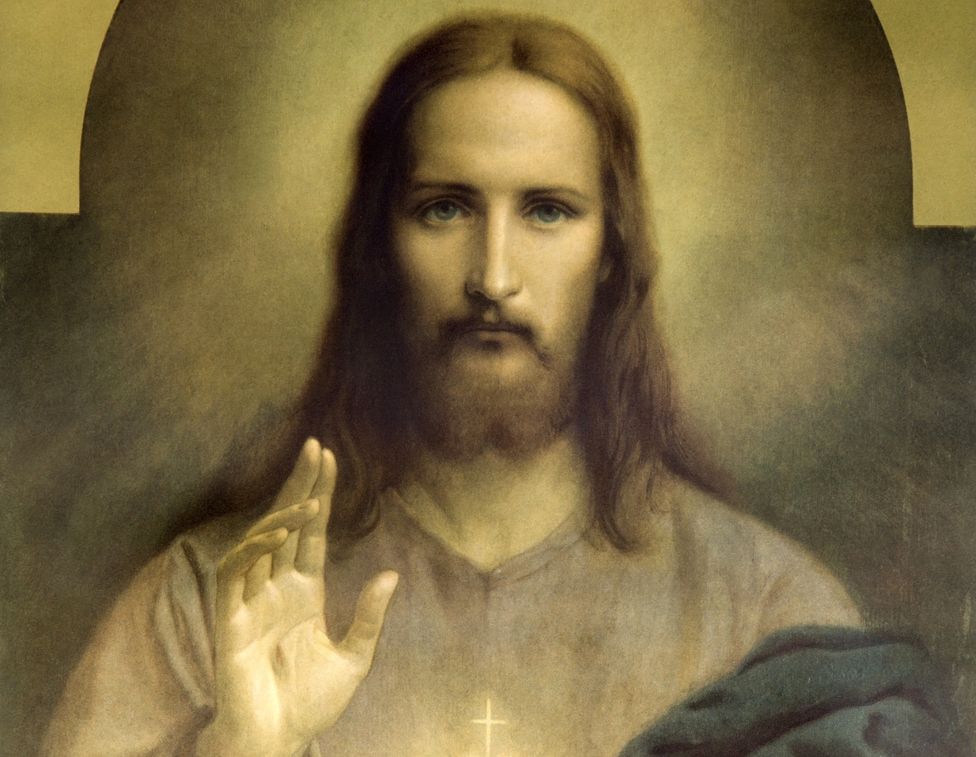
IMAGE SOURCE,THINKSTOCK
Everyone knows what Jesus looks like. He is the most painted figure in all of Western art, recognised everywhere as having long hair and a beard, a long robe with long sleeves (often white) and a mantle (often blue).
Jesus is so familiar that he can be recognised on pancakes or pieces of toast.
But did he really look like this?
Probably not.
In fact this familiar image of Jesus actually comes from the Byzantine era, from the 4th Century onwards, and Byzantine representations of Jesus were symbolic - they were all about meaning, not historical accuracy.
They were based on the image of an enthroned emperor, as we see in the altar mosaic of the Santa Pudenziana church in Rome.
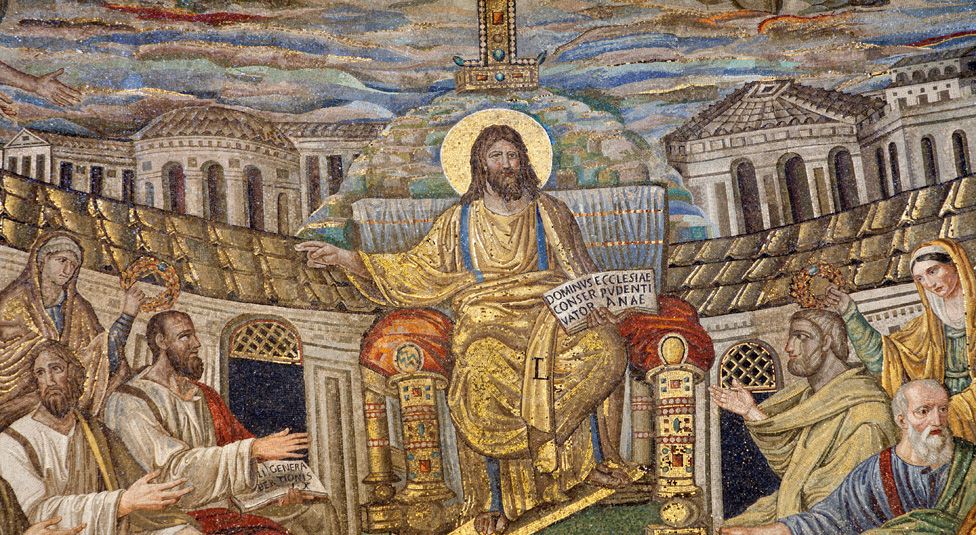
Everyone knows what Jesus looks like. He is the most painted figure in all of Western art, recognised everywhere as having long hair and a beard, a long robe with long sleeves (often white) and a mantle (often blue).
Jesus is so familiar that he can be recognised on pancakes or pieces of toast.
But did he really look like this?
Probably not.
In fact this familiar image of Jesus actually comes from the Byzantine era, from the 4th Century onwards, and Byzantine representations of Jesus were symbolic - they were all about meaning, not historical accuracy.
They were based on the image of an enthroned emperor, as we see in the altar mosaic of the Santa Pudenziana church in Rome.

IMAGE SOURCE,ALAMYImage caption,
The halo also comes from classical art - it was originally a feature of the sun god (Apollo, or Sol Invictus) but was added to Jesus's head to show his heavenly nature
Jesus is dressed in a gold toga. He is the heavenly ruler of all the world, familiar from the famous statue of long-haired and bearded Olympian Zeus on a throne - a statue so well-known that the Roman Emperor Augustus had a copy of himself made in the same style (without the godly long hair and beard).
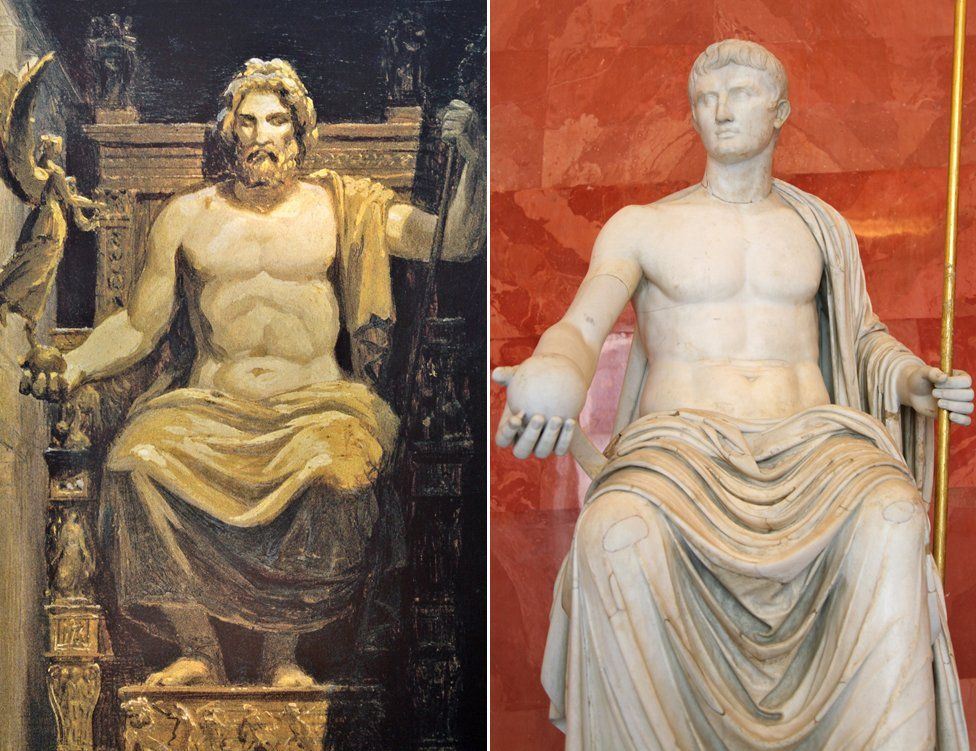
The halo also comes from classical art - it was originally a feature of the sun god (Apollo, or Sol Invictus) but was added to Jesus's head to show his heavenly nature
Jesus is dressed in a gold toga. He is the heavenly ruler of all the world, familiar from the famous statue of long-haired and bearded Olympian Zeus on a throne - a statue so well-known that the Roman Emperor Augustus had a copy of himself made in the same style (without the godly long hair and beard).

IMAGE SOURCE, ALAMY/GETTY IMAGES
Byzantine artists, looking to show Christ's heavenly rule as cosmic King, invented him as a younger version of Zeus. What has happened over time is that this visualisation of heavenly Christ - today sometimes remade along hippie lines - has become our standard model of the early Jesus.
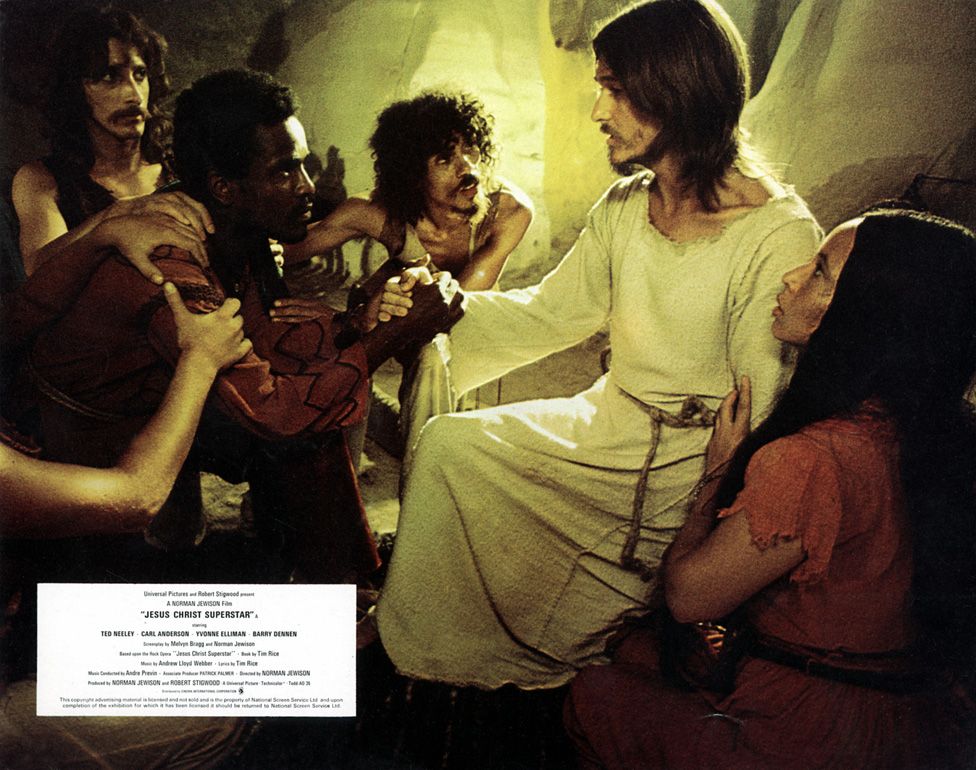
Byzantine artists, looking to show Christ's heavenly rule as cosmic King, invented him as a younger version of Zeus. What has happened over time is that this visualisation of heavenly Christ - today sometimes remade along hippie lines - has become our standard model of the early Jesus.

IMAGE SOURCE,ALAMY
So what did Jesus really look like?
Let's go from head to toe.
1. Hair and beard
When early Christians were not showing Christ as heavenly ruler, they showed Jesus as an actual man like any other: beardless and short-haired.
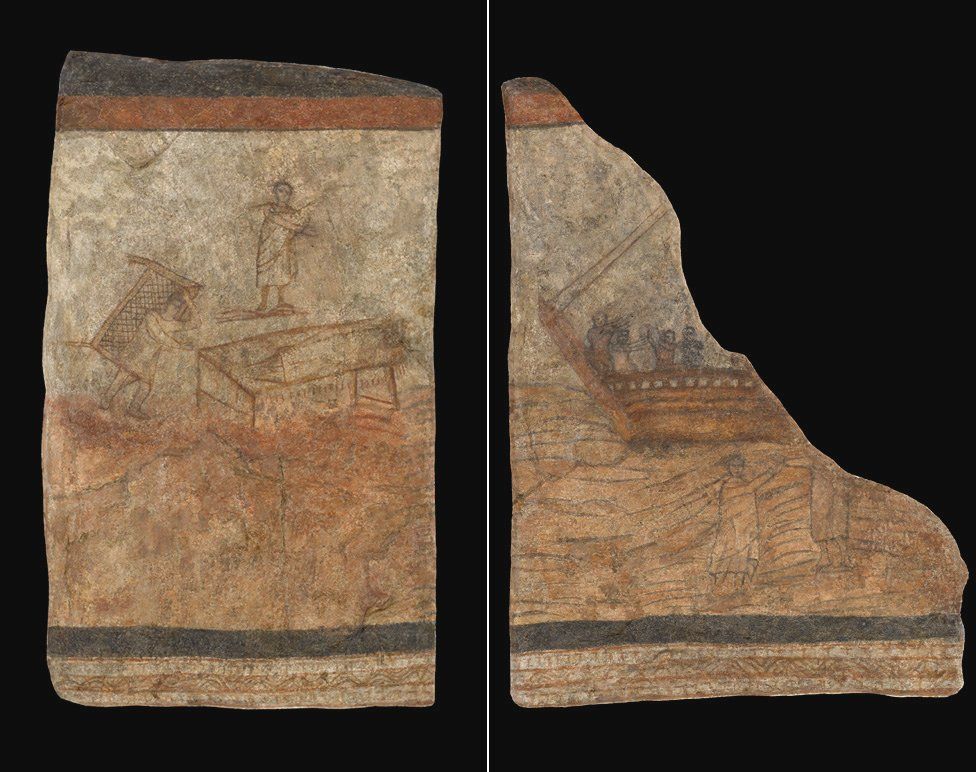
So what did Jesus really look like?
Let's go from head to toe.
1. Hair and beard
When early Christians were not showing Christ as heavenly ruler, they showed Jesus as an actual man like any other: beardless and short-haired.

IMAGE SOURCE,YALE COLLECTIONS/PUBLIC DOMAINImage caption,The earliest surviving paintings of Jesus, from the church at the ruined city of Dura-Europos on the Euphrates (dating from first half of the 3rd Century AD)
But perhaps, as a kind of wandering sage, Jesus would have had a beard, for the simple reason that he did not go to barbers.
General scruffiness and a beard were thought to differentiate a philosopher (who was thinking of higher things) from everyone else. The Stoic philosopher Epictetus considered it "appropriate according to Nature".
Otherwise, in the 1st Century Graeco-Roman world, being clean-shaven and short-haired was considered absolutely essential. A great mane of luxuriant hair and a beard was a godly feature, not replicated in male fashion. Even a philosopher kept his hair fairly short.
A beard was not distinctive of being a Jew in antiquity. In fact, one of the problems for oppressors of Jews at different times was identifying them when they looked like everyone else (a point made in the book of Maccabees). However, images of Jewish men on Judaea Capta coins, issued by Rome after the capture of Jerusalem in 70AD, indicate captive men who are bearded.
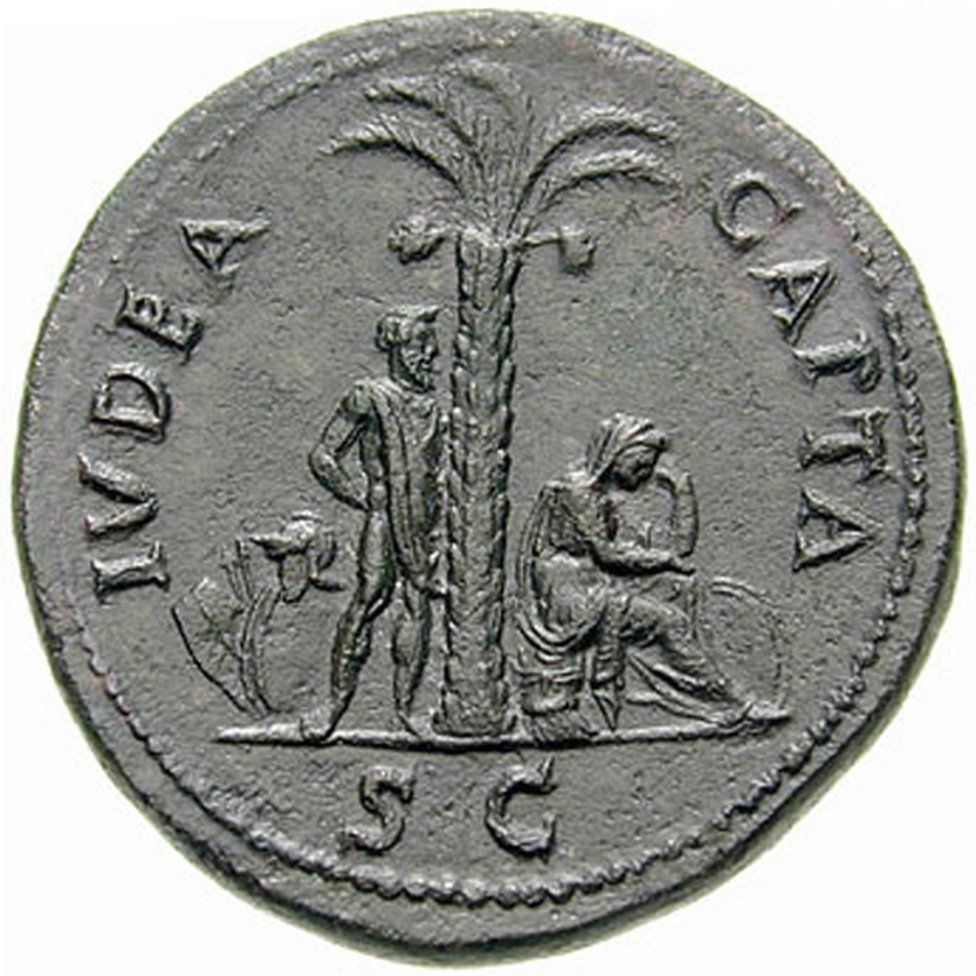
IMAGE SOURCE,CNG COINS
So Jesus, as a philosopher with the "natural" look, might well have had a short beard, like the men depicted on Judaea Capta coinage, but his hair was probably not very long.
If he had had even slightly long hair, we would expect some reaction. Jewish men who had unkempt beards and were slightly long-haired were immediately identifiable as men who had taken a Nazirite vow. This meant they would dedicate themselves to God for a period of time, not drink wine or cut their hair - and at the end of this period they would shave their heads in a special ceremony in the temple in Jerusalem (as described in Acts chapter 21, verse 24).
But Jesus did not keep a Nazirite vow, because he is often found drinking wine - his critics accuse him of drinking far, far too much of it (Matthew chapter 11, verse 19). If he had had long hair, and looked like a Nazirite, we would expect some comment on the discrepancy between how he appeared and what he was doing - the problem would be that he was drinking wine at all.
2. Clothing
At the time of Jesus, wealthy men donned long robes for special occasions, to show off their high status in public. In one of Jesus's teachings, he says, "Beware of the scribes, who desire to walk in long robes (stolai), and to have salutations in the marketplaces, and have the most important seats in the synagogues and the places of honour at banquets" (Mark chapter 12, verses 38-39).
The sayings of Jesus are generally considered the more accurate parts of the Gospels, so from this we can assume that Jesus really did not wear such robes.
Overall a man in Jesus's world would wear a knee-length tunic, a chiton, and a woman an ankle-length one, and if you swapped these around it was a statement. Thus, in the 2nd Century Acts of Paul and Thecla, when Thecla, a woman, dons a short (male) tunic it is a bit of a shock. These tunics would often have coloured bands running from the shoulder to the hem and could be woven as one piece.
On top of the tunic you would wear a mantle, a himation, and we know that Jesus wore one of these because this is what a woman touched when she wanted to be healed by him (see, for example, Mark chapter 5, verse 27). A mantle was a large piece of woollen material, though it was not very thick and for warmth you would want to wear two.
A himation, which could be worn in various ways, like a wrap, would hang down past the knees and could completely cover the short tunic. (Certain ascetic philosophers even wore a large himation without the tunic, leaving their upper right torso bare, but that is another story.)
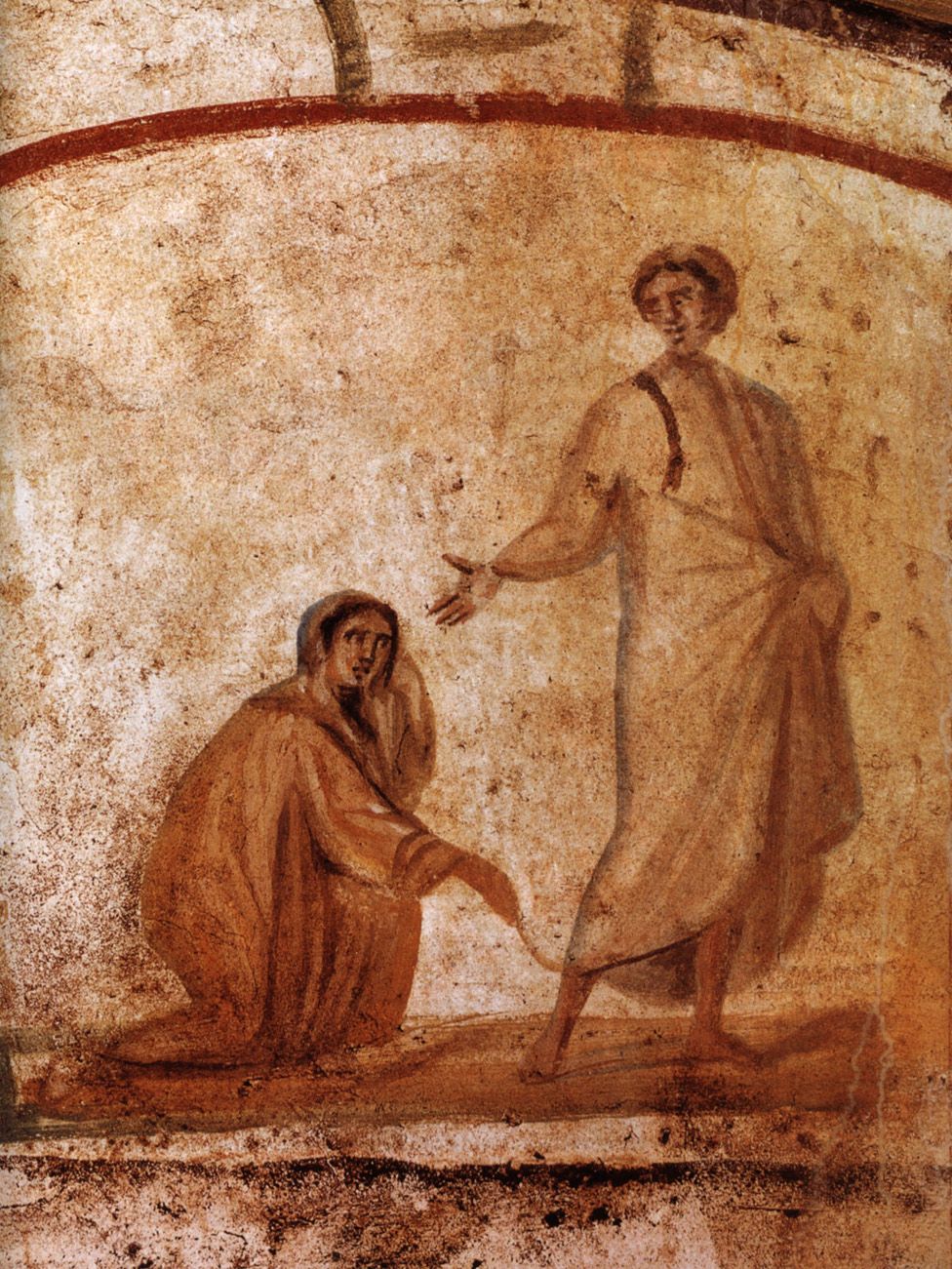
So Jesus, as a philosopher with the "natural" look, might well have had a short beard, like the men depicted on Judaea Capta coinage, but his hair was probably not very long.
If he had had even slightly long hair, we would expect some reaction. Jewish men who had unkempt beards and were slightly long-haired were immediately identifiable as men who had taken a Nazirite vow. This meant they would dedicate themselves to God for a period of time, not drink wine or cut their hair - and at the end of this period they would shave their heads in a special ceremony in the temple in Jerusalem (as described in Acts chapter 21, verse 24).
But Jesus did not keep a Nazirite vow, because he is often found drinking wine - his critics accuse him of drinking far, far too much of it (Matthew chapter 11, verse 19). If he had had long hair, and looked like a Nazirite, we would expect some comment on the discrepancy between how he appeared and what he was doing - the problem would be that he was drinking wine at all.
2. Clothing
At the time of Jesus, wealthy men donned long robes for special occasions, to show off their high status in public. In one of Jesus's teachings, he says, "Beware of the scribes, who desire to walk in long robes (stolai), and to have salutations in the marketplaces, and have the most important seats in the synagogues and the places of honour at banquets" (Mark chapter 12, verses 38-39).
The sayings of Jesus are generally considered the more accurate parts of the Gospels, so from this we can assume that Jesus really did not wear such robes.
Overall a man in Jesus's world would wear a knee-length tunic, a chiton, and a woman an ankle-length one, and if you swapped these around it was a statement. Thus, in the 2nd Century Acts of Paul and Thecla, when Thecla, a woman, dons a short (male) tunic it is a bit of a shock. These tunics would often have coloured bands running from the shoulder to the hem and could be woven as one piece.
On top of the tunic you would wear a mantle, a himation, and we know that Jesus wore one of these because this is what a woman touched when she wanted to be healed by him (see, for example, Mark chapter 5, verse 27). A mantle was a large piece of woollen material, though it was not very thick and for warmth you would want to wear two.
A himation, which could be worn in various ways, like a wrap, would hang down past the knees and could completely cover the short tunic. (Certain ascetic philosophers even wore a large himation without the tunic, leaving their upper right torso bare, but that is another story.)

IMAGE SOURCE,WIKI COMMONSImage caption,
A himation might seem not unlike a Roman toga, but togas were circular (folded into a semi-circle to wear) and himatia were rectangular - modern toga parties, using sheets, are generally himation parties
Power and prestige were indicated by the quality, size and colour of these mantles. Purple and certain types of blue indicated grandeur and esteem. These were royal colours because the dyes used to make them were very rare and expensive.
But colours could also indicate something else. The historian Josephus describes the Zealots (a Jewish group who wanted to push the Romans out of Judaea) as a bunch of murderous transvestites who donned "dyed mantles" - chlanidia - indicating that they were women's wear. This suggests that real men, unless they were of the highest status, should wear undyed clothing.
Jesus did not wear white, however. This was distinctive, requiring bleaching or chalking, and in Judaea it was associated with a group called the Essenes - who followed a strict interpretation of Jewish law. The difference between Jesus's clothing and bright, white clothing, is described in Mark chapter 9, when three apostles accompany Jesus to a mountain to pray and he begins to radiate light. Mark recounts that Jesus's himatia (in the plural the word may mean "clothing" or "clothes" rather than specifically "mantles") began "glistening, intensely white, as no fuller on earth could bleach them". Before his transfiguration, therefore, Jesus is presented by Mark as an ordinary man, wearing ordinary clothes, in this case undyed wool, the material you would send to a fuller.
We are told more about Jesus's clothing during his execution, when the Roman soldiers divide his himatia (in this case the word probably refers to two mantles) into four shares (see John chapter 19, verse 23). One of these was probably a tallith, or Jewish prayer shawl. This mantle with tassels (tzitzith) is specifically referred to by Jesus in Matthew chapter 23, verse 5. This was a lightweight himation, traditionally made of undyed creamy-coloured woollen material, and it probably had some kind of an indigo stripe or threading.
3. Feet
On his feet, Jesus would have worn sandals. Everyone wore sandals. In the desert caves close to the Dead Sea and Masada, sandals from the time of Jesus have come to light, so we can see exactly what they were like. They were very simple, with the soles made of thick pieces of leather sewn together, and the upper parts made of straps of leather going through the toes.

A himation might seem not unlike a Roman toga, but togas were circular (folded into a semi-circle to wear) and himatia were rectangular - modern toga parties, using sheets, are generally himation parties
Power and prestige were indicated by the quality, size and colour of these mantles. Purple and certain types of blue indicated grandeur and esteem. These were royal colours because the dyes used to make them were very rare and expensive.
But colours could also indicate something else. The historian Josephus describes the Zealots (a Jewish group who wanted to push the Romans out of Judaea) as a bunch of murderous transvestites who donned "dyed mantles" - chlanidia - indicating that they were women's wear. This suggests that real men, unless they were of the highest status, should wear undyed clothing.
Jesus did not wear white, however. This was distinctive, requiring bleaching or chalking, and in Judaea it was associated with a group called the Essenes - who followed a strict interpretation of Jewish law. The difference between Jesus's clothing and bright, white clothing, is described in Mark chapter 9, when three apostles accompany Jesus to a mountain to pray and he begins to radiate light. Mark recounts that Jesus's himatia (in the plural the word may mean "clothing" or "clothes" rather than specifically "mantles") began "glistening, intensely white, as no fuller on earth could bleach them". Before his transfiguration, therefore, Jesus is presented by Mark as an ordinary man, wearing ordinary clothes, in this case undyed wool, the material you would send to a fuller.
We are told more about Jesus's clothing during his execution, when the Roman soldiers divide his himatia (in this case the word probably refers to two mantles) into four shares (see John chapter 19, verse 23). One of these was probably a tallith, or Jewish prayer shawl. This mantle with tassels (tzitzith) is specifically referred to by Jesus in Matthew chapter 23, verse 5. This was a lightweight himation, traditionally made of undyed creamy-coloured woollen material, and it probably had some kind of an indigo stripe or threading.
3. Feet
On his feet, Jesus would have worn sandals. Everyone wore sandals. In the desert caves close to the Dead Sea and Masada, sandals from the time of Jesus have come to light, so we can see exactly what they were like. They were very simple, with the soles made of thick pieces of leather sewn together, and the upper parts made of straps of leather going through the toes.

IMAGE SOURCE,GABI LARONImage caption,
Leather sandals belonging to a Sicarii - child, man, and woman. Horowitz G. The Story of Masada. Exhibition catalogue 1993. Jerusalem: The Hebrew University, The Israel Antiquity Authority and the Israel Exploration Society
4. Features
And what about Jesus's facial features? They were Jewish. That Jesus was a Jew (or Judaean) is certain in that it is found repeated in diverse literature, including in the letters of Paul. And, as the Letter to the Hebrews states: "It is clear that our Lord was descended from Judah." So how do we imagine a Jew at this time, a man "about 30 years of age when he began," according to Luke chapter 3?
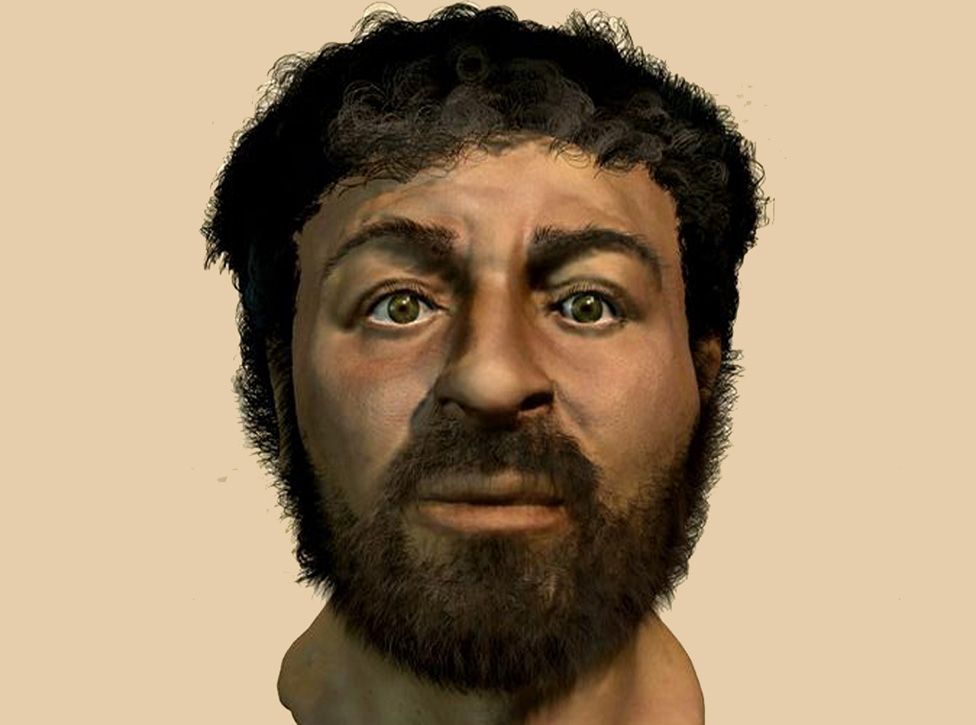
In 2001 forensic anthropologist Richard Neave created a model of a Galilean man for a BBC documentary, Son of God, working on the basis of an actual skull found in the region. He did not claim it was Jesus's face. It was simply meant to prompt people to consider Jesus as being a man of his time and place, since we are never told he looked distinctive.
Leather sandals belonging to a Sicarii - child, man, and woman. Horowitz G. The Story of Masada. Exhibition catalogue 1993. Jerusalem: The Hebrew University, The Israel Antiquity Authority and the Israel Exploration Society
4. Features
And what about Jesus's facial features? They were Jewish. That Jesus was a Jew (or Judaean) is certain in that it is found repeated in diverse literature, including in the letters of Paul. And, as the Letter to the Hebrews states: "It is clear that our Lord was descended from Judah." So how do we imagine a Jew at this time, a man "about 30 years of age when he began," according to Luke chapter 3?

In 2001 forensic anthropologist Richard Neave created a model of a Galilean man for a BBC documentary, Son of God, working on the basis of an actual skull found in the region. He did not claim it was Jesus's face. It was simply meant to prompt people to consider Jesus as being a man of his time and place, since we are never told he looked distinctive.
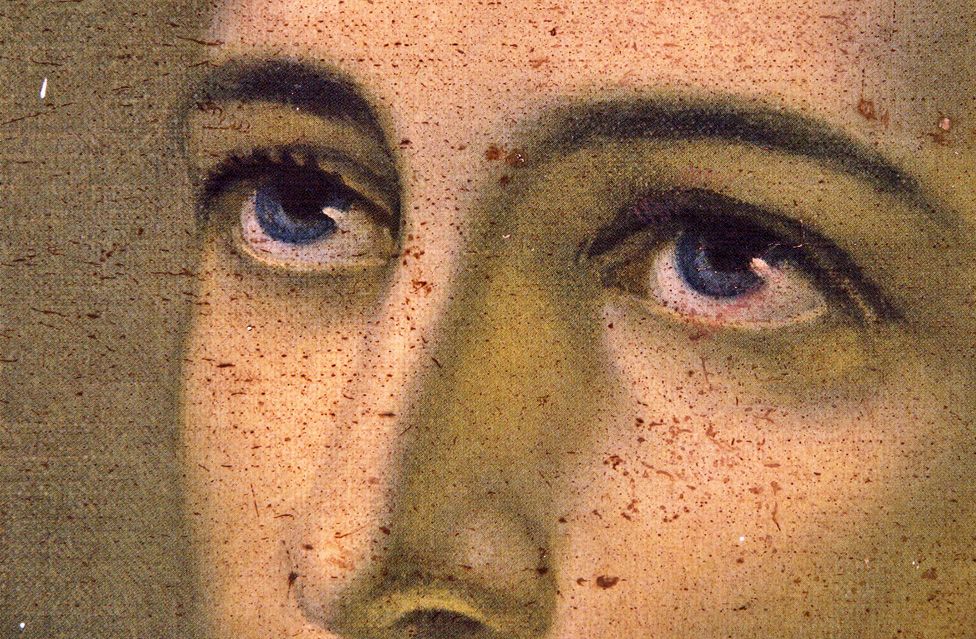
IMAGE SOURCE,ALAMYImage caption,
Whatever some artists may imagine, such as the creator of this fresco in Crete, Jesus is unlikely to have had blue eyes
For all that may be done with modelling on ancient bones, I think the closest correspondence to what Jesus really looked like is found in the depiction of Moses on the walls of the 3rd Century synagogue of Dura-Europos, since it shows how a Jewish sage was imagined in the Graeco-Roman world. Moses is imagined in undyed clothing, and in fact his one mantle is a tallith, since in the Dura image of Moses parting the Red Sea one can see tassels (tzitzith) at the corners. At any rate, this image is far more correct as a basis for imagining the historical Jesus than the adaptations of the Byzantine Jesus that have become standard: he's short-haired and with a slight beard, and he's wearing a short tunic, with short sleeves, and a himation.
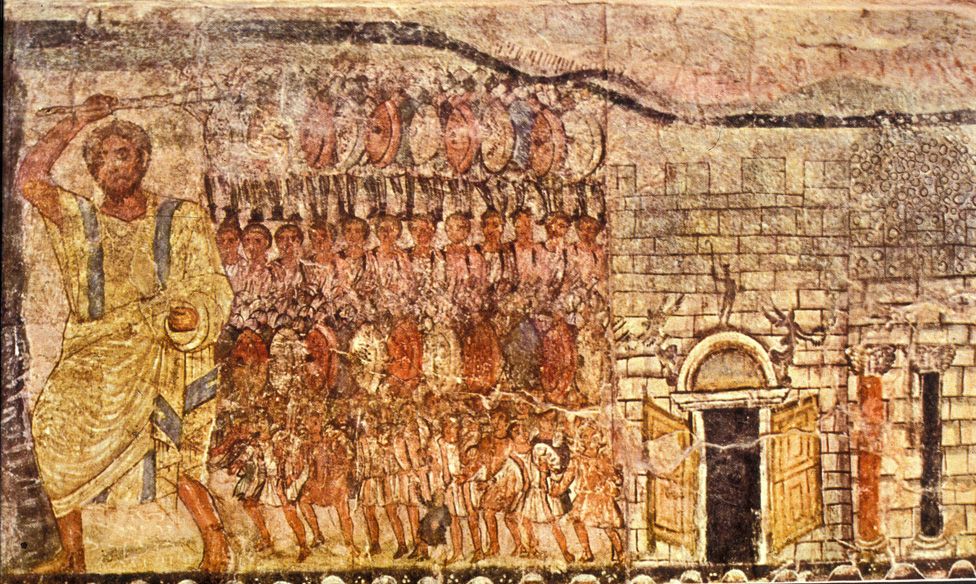
Whatever some artists may imagine, such as the creator of this fresco in Crete, Jesus is unlikely to have had blue eyes
For all that may be done with modelling on ancient bones, I think the closest correspondence to what Jesus really looked like is found in the depiction of Moses on the walls of the 3rd Century synagogue of Dura-Europos, since it shows how a Jewish sage was imagined in the Graeco-Roman world. Moses is imagined in undyed clothing, and in fact his one mantle is a tallith, since in the Dura image of Moses parting the Red Sea one can see tassels (tzitzith) at the corners. At any rate, this image is far more correct as a basis for imagining the historical Jesus than the adaptations of the Byzantine Jesus that have become standard: he's short-haired and with a slight beard, and he's wearing a short tunic, with short sleeves, and a himation.

IMAGE SOURCE,ALAMY
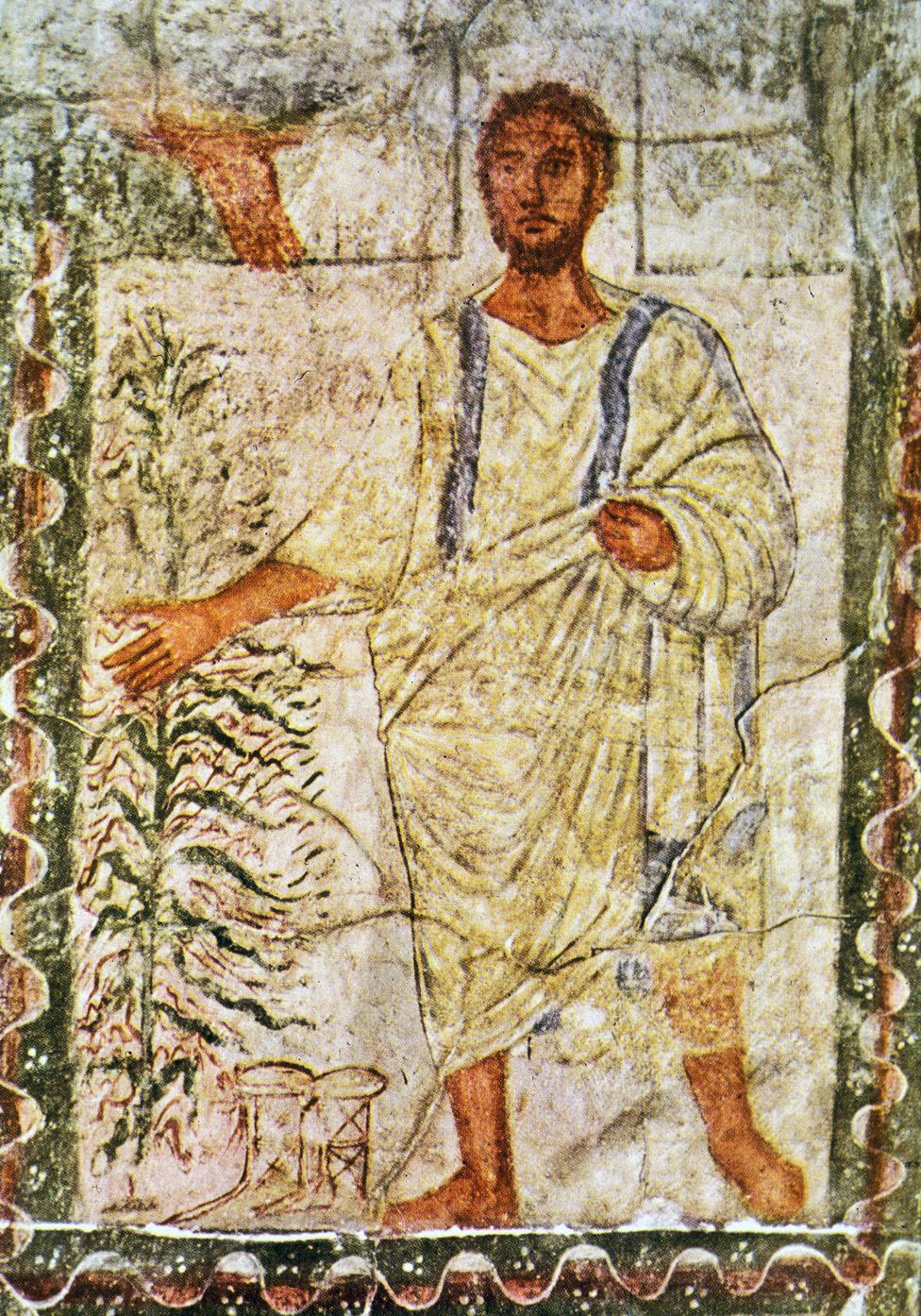

IMAGE SOURCE,ALAMYImage caption,
Moses appears to be wearing a tunic with blue bands, as well as a tallith (as a mantle) with blue decoration - in both cases the blue would probably have been created by dying with indigo
Joan Taylor is professor of Christian Origins and Second Temple Judaism at King's College London and the author of The Essenes, the Scrolls and the Dead Sea.
Moses appears to be wearing a tunic with blue bands, as well as a tallith (as a mantle) with blue decoration - in both cases the blue would probably have been created by dying with indigo
Joan Taylor is professor of Christian Origins and Second Temple Judaism at King's College London and the author of The Essenes, the Scrolls and the Dead Sea.
When was Jesus starting been depictured as a White?
ReplyDeleteIn that Roman time?
Or he was been subsequently transmogrified later during the crusader's period?
In the very heart of the crusade is the dogma of WASP.
White Anglo Saxon Protestant!
Does that ordering of the words, rings a bell?
It's definitely NO subconscious reminisce. It's a yearning for a ironclads supremacy - modelled & lamented under their race!
She missed 1 important thing abt Jesus n the language he spoke n used for the Gospel/Injil?
ReplyDeleteIt is Suryani/Assyriac? It wasnot Hebrew or English or Greek. Some claimed he was a polyglot under the Roman Empire?
a Galilean dialect of Aramaic
DeleteThis whole article is an attempt to impose post-2000's Woke mentality in judgement on 20 centuries of Christian cultural attitudes.
ReplyDeleteThe way Jesus Christ was depicted in Renaissance Italy paintings and books shaped the mental images Europeans had in subsequent centuries.
It wasn't racism, artists simply drew images looking like people around them - White Europeans.
Protestantism didn't even exist then, and England was a poor , underdeveloped land. So blaming "WASP" attitudes is Bullshit.
It's the same way Chinese images of the Jade Emperor look like a Chinese man.
Wakakakaka…
DeleteKnow-nothing fart intertwined with cesspool concentrates!
The crusade period runs from 1095 – 1291. It's during these period that many of the orthodontics Europeans came into first extensive contacts with races outside their Europe centric, or white-skin, bronze-hair features societal settings.
This gave those white crusaders an unprecedented mental shock that the people residing in their holy land were differed so much more from them as a god fearing race.
Before that encounter, most of the old European deities featuring their gods in their resemblances - to enforce that concept of they were been created in their supreme being's image.
That's excusable as their ignorant Europecentric , bred via their closed environment, allowed them to image their ultimate superbeing as of their own race.
The establishment of the Protestantism by Reformation took place, 500 years ago, as Martin Luther (1483-1546) tried to reform the Catholic Church.
Luther had strongly reinforced that Anglo Saxon
supremacist's dogma deep into the core of the Protestantism.
Henceforth, all the images of the Jesus were of the white, blue-eyed & bronze-hair copycat!
It was an upmost blasphemy that their all powerful creator could be a being very different from their own race!
BTW, there is NOTHING wrong for the Chinese image of the Jade Emperor to look like a Chinese man!
BCOZ, the Jade Emperor was/is the god of the Chinese ONLY. Not the omnipotent monotheistic god of the Abrahamic faith that governs ALL human races!
Bet, u never be able to tell that A from B when u r do engrossed in that foul gaseous of that fart filled well!